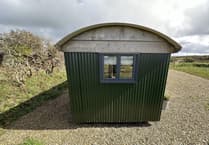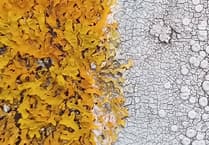What is surely the world's largest coracle has arrived in Pembrokeshire. The 'coracle' is currently in kit form: 51 sections, each up to 23m long, of softwood 'glulam' beam. The beams have been carried by three lorries from Switzerland to the Bluestone new generation holiday village near Narberth. There, they will form the structure of Bluestone's waterpark, the name of which has yet to be revealed. Over the coming weeks, the beams will be erected to form a unique structure, 90m long by 40m wide by 18m high, in the shape of an upturned coracle - specifically a Cleddau coracle. The shape has not come about by accident. Architect Gareth Howell, of Powell Dobson, explained: "When I began sketching ideas at a conceptual stage, the shape of an upturned boat and organic form came naturally to the fore. "After further research into boat-building techniques and timber construction, I started thinking about coracles, discovering that coracles differed in design according to which river they were to be used upon. "Consequently, as the scheme developed the form of the building started to reflect the 'rounded front and squared end' shape of coracles traditionally used on the River Cleddau, which runs close to the Bluestone site. "The traditional method of constructing coracles, involving laths of wood woven together with a hide envelope, is also reflected in this concept which uses a timber glu-laminated superstructure and a combination of cedar shingles and ETFE* foil membrane similar to that used in the Eden Project as the outer skin for the waterpark." Though many of the materials used in the construction of the waterpark are being sourced locally, the beams have been made by Swiss specialists, Harings. An innovative family-owned engineering and technology company based in Pratteln, Harings pride themselves on setting new standards for sustainable products and solutions in the building industry. 'Glulam' comprises many layers of selected softwood bonded together. The result is one of the strongest structural materials per unit of weight. It also allows the construction of domed structures of considerable size, with great flexibility in terms of the shapes achievable. "In terms of sustainability, glulam also has several advantages over steel or concrete," added Bluestone chief executive, William McNamara. "Timber is the only renewable building material, and all Harings' timber is sourced from sustainably-grown and harvested Forestry Stewardship Council-certified forests in Switzerland, within 100km of the production plant. "Compared to steel or concrete, glulam beams are also much more energy-efficient to produce. Making a 305mm by 165mm steel 'I' beam requires six times more energy to produce than a glulam beam of similar performance. A concrete beam of similar performance would require five times the energy to make. "The insulation properties of timber are well- known, so glulam is also energy-efficient in use."

Chief executive William McNamara watches the arrival of the beams.
More About:



